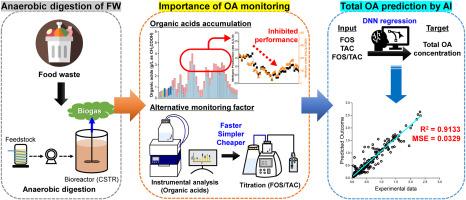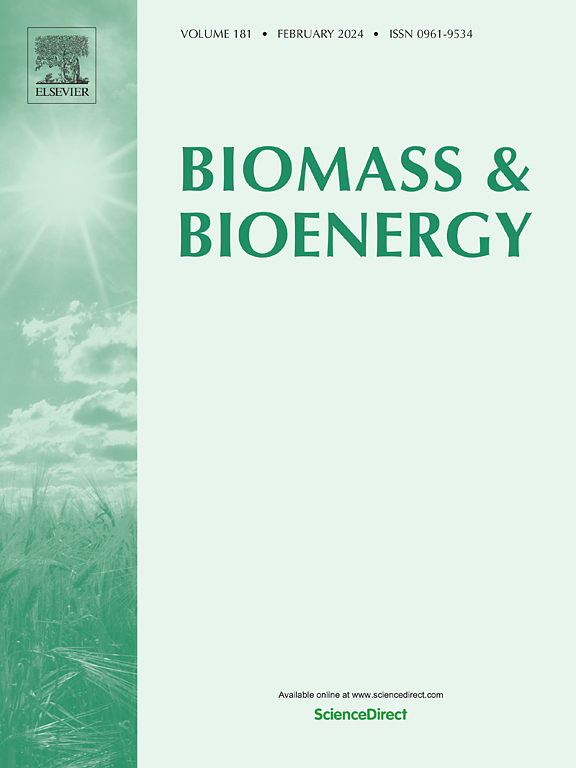Prediction of total organic acids concentration based on FOS/TAC titration in continuous anaerobic digester fed with food waste using a deep neural network model
IF 5.8
2区 生物学
Q1 AGRICULTURAL ENGINEERING
引用次数: 0
Abstract
In this work, the complexities of anaerobic digestion fed with highly degradable feedstock are investigated, focusing on accumulation of organic acids (OA) as a critical monitoring parameter, and the significance of prediction models for total OA concentration. The anaerobic digestion of food waste (FW) was conducted under the organic loading rate (OLR) range of 2.55–8.80 g COD/L/d and hydraulic retention time (HRT) of 30–15 days. The feasibility of flüchtige organische säuren (FOS), totales anorganisches carbonat (TAC), and the FOS/TAC was investigated by predicting the total OA using a deep neural network (DNN) model. Two digesters, Digester 1 and 2, were fed with FW from four distinct sites. When the OA concentration exceeded 2 g/L as CH3COOH, the feeding was paused to recover the methanogens activity. The total OA concentration was successfully predicted with FOS, TAC, and FOS/TAC using the DNN regression model even though applying on the datasets from two distinct digesters, indicating a R-value of 0.9557, R2 of 0.9133, and mean square error of 0.0329. The predictive capability of DNN regression model shows the feasibility of total OA prediction based on the titrimetric method for monitoring and optimizing continuous anaerobic digestion of highly degradable feedstock.

利用深度神经网络模型,根据 FOS/TAC 滴定法预测以厨余为原料的连续厌氧消化器中的总有机酸浓度
在这项工作中,研究了以高降解性原料为喂料的厌氧消化的复杂性,重点是作为关键监测参数的有机酸(OA)的积累,以及总 OA 浓度预测模型的意义。在有机负荷率(OLR)为 2.55-8.80 克 COD/L/d 和水力停留时间(HRT)为 30-15 天的条件下,对食物垃圾(FW)进行了厌氧消化。通过使用深度神经网络(DNN)模型预测总OA,研究了flüchtige organicische säuren(FOS)、totales anorganisches carbonat(TAC)和FOS/TAC的可行性。两个消化器(消化器 1 和 2)分别向四个不同地点的 FW 进料。当 OA 浓度超过 2 克/升(以 CH3COOH 计)时,暂停进料以恢复甲烷菌的活性。使用 DNN 回归模型成功预测了 FOS、TAC 和 FOS/TAC 的总 OA 浓度,即使应用的是两个不同消化器的数据集,R 值为 0.9557,R2 为 0.9133,均方误差为 0.0329。DNN 回归模型的预测能力表明,基于滴定法的总 OA 预测对于监测和优化高降解性原料的连续厌氧消化是可行的。
本文章由计算机程序翻译,如有差异,请以英文原文为准。
求助全文
约1分钟内获得全文
求助全文
来源期刊

Biomass & Bioenergy
工程技术-能源与燃料
CiteScore
11.50
自引率
3.30%
发文量
258
审稿时长
60 days
期刊介绍:
Biomass & Bioenergy is an international journal publishing original research papers and short communications, review articles and case studies on biological resources, chemical and biological processes, and biomass products for new renewable sources of energy and materials.
The scope of the journal extends to the environmental, management and economic aspects of biomass and bioenergy.
Key areas covered by the journal:
• Biomass: sources, energy crop production processes, genetic improvements, composition. Please note that research on these biomass subjects must be linked directly to bioenergy generation.
• Biological Residues: residues/rests from agricultural production, forestry and plantations (palm, sugar etc), processing industries, and municipal sources (MSW). Papers on the use of biomass residues through innovative processes/technological novelty and/or consideration of feedstock/system sustainability (or unsustainability) are welcomed. However waste treatment processes and pollution control or mitigation which are only tangentially related to bioenergy are not in the scope of the journal, as they are more suited to publications in the environmental arena. Papers that describe conventional waste streams (ie well described in existing literature) that do not empirically address ''new'' added value from the process are not suitable for submission to the journal.
• Bioenergy Processes: fermentations, thermochemical conversions, liquid and gaseous fuels, and petrochemical substitutes
• Bioenergy Utilization: direct combustion, gasification, electricity production, chemical processes, and by-product remediation
• Biomass and the Environment: carbon cycle, the net energy efficiency of bioenergy systems, assessment of sustainability, and biodiversity issues.
 求助内容:
求助内容: 应助结果提醒方式:
应助结果提醒方式:


